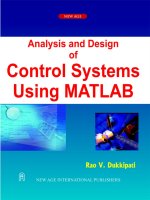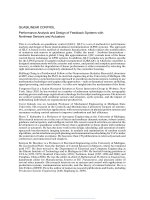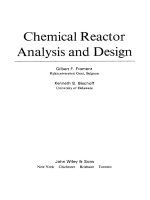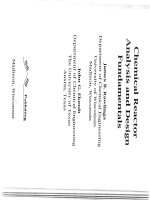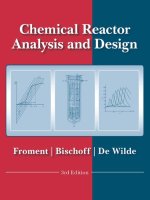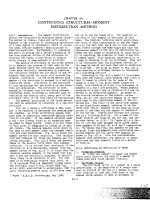principles of chemical reactor analysis and design new tools for industrial chemical reactor operations
Bạn đang xem bản rút gọn của tài liệu. Xem và tải ngay bản đầy đủ của tài liệu tại đây (3.15 MB, 494 trang )
PRINCIPLES OF
CHEMICAL REACTOR
ANALYSIS AND DESIGN
New Tools for Industrial
Chemical Reactor Operations
Second Edition
UZI MANN
Texas Tech University
PRINCIPLES OF
CHEMICAL REACTOR
ANALYSIS AND DESIGN
PRINCIPLES OF
CHEMICAL REACTOR
ANALYSIS AND DESIGN
New Tools for Industrial
Chemical Reactor Operations
Second Edition
UZI MANN
Texas Tech University
Copyright # 2009 by John Wiley & Sons, Inc. All rights reserved
Published by John Wiley & Sons, Inc., Hoboken, New Jersey
Published simultaneously in Canada
No part of this publication may be reproduced, stored in a retrieval system, or transmitted in any form or
by any means, electronic, mechanical, photocopying, recording, scanning, or otherwise, except as
permitted under Section 107 or 108 of the 1976 United States Copyright Act, without either the prior written
permission of the Publisher, or authorization through payment of the appropriate per-copy fee to the
Copyright Clearance Center, Inc., 222 Rosewood Drive, Danvers, MA 01923, (978) 750-8400, fax (978)
750-4470, or on the web at www.copyright.com. Requests to the Publisher for permission should be addressed
to the Permissions Department, John Wiley & Sons, Inc., 111 River Street, Hoboken, NJ 07030, (201) 748-6011,
fax (201) 748-6008, or online at />Limit of Liability/Disclaimer of Warranty: While the publisher and author have used their best efforts in
preparing this book, they make no representations or warranties with respect to the accuracy or completeness
of the contents of this book and specifically disclaim any implied warranties of merchantability or fitness
for a particular purpose. No warranty may be created or extended by sales representatives or written sales materials.
The advice and strategies contained herein may not be suitable for your situation. You should consult with a
professional where appropriate. Neither the publisher nor author shall be liable for any loss of profit or any other
commercial damages, including but not limited to special, incidental, consequential, or other damages.
For general information on our other products and services or for technical support, please contact our
Customer Care Department within the United States at (800) 762-2974, outside the United States at
(317) 572-3993 or fax (317) 572-4002.
Wiley also publishes its books in variety of electronic formats. Some content that appears in print may not be
available in electronic formats. For more information about Wiley products, visit our web site at www.wiley.com.
Library of Congress Cataloging-in-Publication Data:
Mann, Uzi
Principles of chemical reactor analysis and design : new tools for industrial chemical reactor
operations / Uzi Mann, M.D. Morris, advisory editor—2nd ed.
p. cm.
Includes index.
ISBN 978-0-471-26180-3 (cloth)
1. Chemical reactors—Design and construction. I. Title.
TP157.M268 2008
660
0
.2832—dc22
2008044359
Printed in the United States of America
10987654321
In memory of my sister, Meira Lavie
To Helen, and to David, Amy, and Joel
“Discovery consists of looking at the same thing as everyone
else and thinking something different.”
Albert Szent-Gyo
¨
rgyi
Nobel Laureate, 1937
CONTENTS
Preface xi
Notation xv
1 Overview of Chemical Reaction Engineering 1
1.1 Classification of Chemical Reactions, 2
1.2 Classification of Chemical Reactors, 3
1.3 Phenomena and Concepts, 8
1.3.1 Stoichiometry, 8
1.3.2 Chemical Kinetics, 9
1.3.3 Transport Effects, 9
1.3.4 Global Rate Expression, 14
1.3.5 Species Balance Equation and Reactor
Design Equation, 14
1.3.6 Energy Balance Equation, 15
1.3.7 Momentum Balance Equation, 15
1.4 Common Practices, 15
1.4.1 Experimental Reactors, 16
1.4.2 Selection of Reactor Configuration, 16
1.4.3 Selection of Operating Conditions, 18
1.4.4 Operational Considerations, 18
1.4.5 Scaleup, 19
1.4.6 Diagnostic Methods, 20
1.5 Industrial Reactors, 20
1.6 Summary, 21
References, 22
vii
2 Stoichiometry 25
2.1 Four Contexts of Chemical Reaction, 25
2.2 Chemical Formulas and Stoichiometric Coefficients, 26
2.3 Extent of a Chemical Reaction, 28
2.4 Independent and Dependent Chemical Reactions, 39
2.5 Characterization of the Reactor Feed, 47
2.5.1 Limiting Reactant, 48
2.5.2 Excess Reactant, 49
2.6 Characterization of Reactor Performance, 54
2.6.1 Reactant Conversion, 54
2.6.2 Product Yield and Selectivity, 58
2.7 Dimensionless Extents, 64
2.8 Independent Species Composition Specifications, 68
2.9 Summary, 72
Problems, 72
Bibliography, 79
3 Chemical Kinetics 81
3.1 Species Formation Rates, 81
3.2 Rates of Chemical Reactions, 82
3.3 Rate Expressions of Chemical Reactions, 86
3.4 Effects of Transport Phenomena, 91
3.5 Characteristic Reaction Time, 91
3.6 Summary, 97
Problems, 97
Bibliography, 99
4 Species Balances and Design Equations 101
4.1 Macroscopic Species Balances—General Species-Based
Design Equations, 102
4.2 Species-Based Design Equations of Ideal Reactors, 104
4.2.1 Ideal Batch Reactor, 104
4.2.2 Continuous Stirred-Tank Reactor (CSTR), 105
4.2.3 Plug-Flow Reactor (PFR), 106
4.3 Reaction-Based Design Equations, 107
4.3.1 Ideal Batch Reactor, 107
4.3.2 Plug-Flow Reactor, 109
4.3.3 Continuous Stirred-Tank Reactor (CSTR), 111
4.3.4 Formulation Procedure, 112
4.4 Dimensionless Design Equations and
Operating Curves, 113
viii CONTENTS
4.5 Summary, 125
Problems, 126
Bibliography, 129
5 Energy Balances 131
5.1 Review of Thermodynamic Relations, 131
5.1.1 Heat of Reaction, 131
5.1.2 Effect of Temperature on Reaction
Equilibrium Constant, 134
5.2 Energy Balances, 135
5.2.1 Batch Reactors, 136
5.2.2 Flow Reactors, 147
5.3 Summary, 156
Problems, 157
Bibliography, 158
6 Ideal Batch Reactor 159
6.1 Design Equations and Auxiliary Relations, 160
6.2 Isothermal Operations with Single Reactions, 166
6.2.1 Constant-Volume Reactors, 167
6.2.2 Gaseous, Variable-Volume
Batch Reactors, 181
6.2.3 Determination of the Reaction
Rate Expression, 189
6.3 Isothermal Operations with Multiple Reactions, 198
6.4 Nonisothermal Operations, 216
6.5 Summary, 230
Problems, 231
Bibliography, 238
7 Plug-Flow Reactor 239
7.1 Design Equations and Auxiliary Relations, 240
7.2 Isothermal Operations with Single Reactions, 245
7.2.1 Design, 246
7.2.2 Determination of Reaction
Rate Expression, 261
7.3 Isothermal Operations with Multiple
Reactions, 265
7.4 Nonisothermal Operations, 281
7.5 Effects of Pressure Drop, 296
7.6 Summary, 308
Problems, 309
CONTENTS ix
8 Continuous Stirred-Tank Reactor 317
8.1 Design Equations and Auxiliary Relations, 318
8.2 Isothermal Operations with Single Reactions, 322
8.2.1 Design of a Single CSTR, 324
8.2.2 Determination of the Reaction Rate
Expression, 333
8.2.3 Cascade of CSTRs Connected in Series, 336
8.3 Isothermal Operations with Multiple Reactions, 341
8.4 Nonisothermal Operations, 358
8.5 Summary, 370
Problems, 370
9 Other Reactor Configurations 377
9.1 Semibatch Reactors, 377
9.2 Plug-Flow Reactor with Distributed Feed, 400
9.3 Distillation Reactor, 416
9.4 Recycle Reactor, 425
9.5 Summary, 435
Problems, 435
10 Economic-Based Optimization 441
10.1 Economic-Based Performance Objective Functions, 442
10.2 Batch and Semibatch Reactors, 448
10.3 Flow Reactors, 450
10.4 Summary, 453
Problems, 453
Bibliography, 454
Appendix A Summary of Key Relationships 455
Appendix B Microscopic Species Balances—Species Continuity
Equations 465
Appendix C Summary of Numerical Differentiation and Integration 469
Index 471
x CONTENTS
PREFACE
I decided to write this book because I was not pleased with the way current
textbooks present the subject of chemical reactor analysis and design. In my
opinion, there are several deficiencies, both contextual and pedagogical, to the
way this subject is now being taught. Here are the main ones:
†
Reactor design is confined to simple reactions. Most textbooks focus on the
design of chemical reactors with single reactions; only a brief discussion is
devoted to reactors with multiple reactions. In practice, of course, engineers
rarely encounter chemical reactors with single reactions.
†
Two design formulations are presented; one for reactors with single reactions
(where the design is expressed in terms of the conversion of a reactant), and
one for reactors with multiple reactions (where the design formulation is based
on writing the species balance equations for all the species that participate
in the reactions). A unified design methodology that applies to all reactor
operations is lacking.
†
The operations of chemical reactors are expressed in terms of extensive,
system-specific parameters (i.e., reactor volume, molar flow rates). In contrast,
the common approach used in the design of most operations in chemical
engineering is based on describing the operation in terms of dimensionless
quantities. Dimensionless formulations provide an insight into the underlining
phenomena that affect the operation, which are lost when the analysis is case
specific.
†
The analysis of chemical reactor operations is limited to simple reactor
configurations (i.e., batch, tubular, CSTR), with little, if any analysis, of other
configurations (i.e., semibatch, tubular with side injection, distillation reactor),
xi
which are commonly used in industry to improve the yield and selectivity of the
desirable product. These rea ctor configurations are discussed qualita tiv ely in
some textbooks, but no design equations are derived or provided.
†
Most examples cover isothermal reactor operations; nonisothermal operations
are sparsely discussed. In the few nonisothermal examples that are presented,
usually single reactions are considered, and the dependency of the heat
capacity of the reacting fluid on the temperature and composition is usually
ignored. Consequently, the effect of the most important factor that affect
the rates of the chemical reactions—the temperature—is not described in
the most comprehensive way possible.
†
In all solved examples, the heat-transfer coefficient is usually specified. But,
what is not mentioned is the fact that the heat transfer can be determined only
after the reactor size and geometry are specified, and the flow conditions
are known. Those, of course, are not known in the initial steps of reactor
design. What is needed is a method to estimate, a priori, the range of heat-
transfer coefficient and then determine what reactor configuration and size
provide them.
Considering those points, the current pedagogy of chemical reactor analysis and
design falls short of providing students with the needed methodology and tools
to address the actual technical challenges they will face in practice.
This book presents a different approach to the analysis of chemical reactor oper-
ations—reaction-based design formulation rather than the common species-based
design formulation. This volume describes a unified methodology that applies to
both single and multiple reactions (reactors with single reactions are merely
simple special cases). The methodology is applicable to any type of chemical reac-
tions (homogeneous, heterogeneous, catalytic) and any form of rate expression.
Reactor operations are described in terms of dimensionless design equations that
generate dimensionless operating curves that describe the progress of the individual
chemical reactions, the composition of species, and the temperature. All parameters
that affect the heat transfer are combined into a single dimensionless number that
can be estimated a priori. Variations in the heat capacity of the reacting fluid are
fully accounted. The methodology is applied readily to all reactor configurations
(including semibatch, recycle, etc.), and it also provides a convenient framework
for economic-based optimization of reactor operations.
One of the most difficult decisions that a textbook writer has to make is to select
what material to cover and what topics to leave out. This is especially difficult in
chemical reaction engineering because of the wide scope of the field and the diver-
sity of topics that it covers. As the title indicates, this book focuses on the analysis
and design of chemical reactors. The objective of the book is to present a compre-
hensive, unified methodology to analyze and design chemical reactors that over-
comes the deficiencies of the current pedagogy. To concentrate on this objective,
some topics that are commonly covered in chemical reaction engineering textbooks
(chemical kinetics, catalysis, effect of diffusion, mass-transfer limitation, etc.) are
xii PREFACE
not covered here. Those topics are discussed in detail in many excellent textbooks,
and the reader is expected to be familiar with them. Also, advanced topics related to
special reactor types (fluidized bed, trickle bed, etc.) are not covered in the text.
Students require knowledge of solving (numerically) simultaneous first-order
differential equations (initial value problems) and multiple nonlinear algebraic
equations. The use of mathematical software that provides numerical solutions to
those types of equations (e.g., Matlab, Mathematica, Maple, Mathcad, Polymath,
HiQ, etc.) is required. Numerical solutions of all the examples in the text are
posted on the book web page.
The problems at the end of each chapter are categorized by their level of difficulty,
indicated by a subscript next to the problem number. Subscript 1 indicates simple
problems that require application of equations provided in the text. Subscript 2
indicates problems whose solutions require some more in-depth analysis and
modifications of given equations. Subscript 3 indicates problems whose solutions
require more comprehensive analysis and involve application of several concepts.
Subscript 4 indicates problems that require the use of a mathematical software or
the writing of a computer code to obtain numerical solutions.
I am indebted to many people for their encouragement and help during the
development of this text. M. D. Morris was the driving force in developing this
book from early conception of the idea to its completion. Stan Emets assisted in
solving and checking the examples, and provided constructive criticism. My
wife, Helen Mann, typed and retyped the text, in which she put not only her
skills, but also her heart.
U
ZI MANN
PREFACE xiii
NOTATION
All quantities are defined in their generic dimensions (length, time, mass or mole,
energy, etc.). Symbols that appear in only one section are not listed. Numbers in
parentheses indicate the equations where the symbol is defined or appears for the
first time.
A
a
C
CF
c
p
c
ˆ
p
D
DHR
d
p
E
E
a
e
F
f
f
G
G
j
g
H
H
ˆ
DH
R
Cross-section area, area
Species activity coefficient
Molar concentration, mole/volume
Correction factor of heat capacity, dimensionless (Eq. 5.2.19)
Mass-based heat capacity at constant pressure, energy/mass K
Molar-based heat capacity at constant pressure, energy/mole K
Reactor (tube) diameter, length
Dimensionless heat of reaction, dimensionless (Eq. 5.2.23)
Particle diameter, length
Total energy, energy
Activation energy, energy/mole extent
Specific energy, energy/mass
Molar flow rate, mole/time
Conversion of a reactant, dimensionless (Eqs. 2.6.1a and 2.6.1b)
Friction factor, dimensionless
Mass velocity, mass/time area
Generation rate of species j in a flow reactor, moles j/time
Gravitational acceleration, length/time
2
Enthalpy, energy
Molar-based specific enthalpy, energy/mole
Heat of reaction, energy/mole extent
xv
h
HTN
J
j
J
K
KE
k, k(T)
k
L
M
MW
m
m
˙
N, N(t)
n
n
(n
j
2n
j
0
)
i
OC
P
PE
Q(t)
Q
˙
R
R
r
(r
j
)
(r
j
)
s
(r
j
)
w
S
s
j
SC
T
t
t
cr
U
U
u
u
V
V
R
Mass-based specific enthalpy, energy/mass
Dimensionless heat-transfer number, dimensionless (Eq. 5.2.22)
Molar flux of species j, mole j/(time area)
Total number of species
Equilibrium constant
Kinetic energy, energy
Reaction rate constant
Index of dependent reactions
Length, length
Mass, mass
Molecular weight, mass/mole
Index of independent reactions
Mass flow rate, mass/time
Molar content in a reactor, moles
Index for chemical reactions
Unit outward vector
Moles of species j formed by the ith reaction, moles of species j
Operating cost
Total pressure, force/area
Potential energy, energy
Heat added to the reactor in time t, energy
Rate heat added to the reactor, energy/time
Gas constant, energy/temperature mole
Recycle ratio (Eq. 9.4.9) dimensionless
Volume-based rate of a chemical reaction, mole extent/time
volume
Volume-based rate of formation of species j, mole j/time volume
Surface-based rate of formation of species j, mole j/time surface
area of catalyst
Mass-based rate of formation of species j, mole j/time catalyst
mass
Surface area, area
Stoichiometric coefficient of species j, mole j/mole extent
Separation cost
Temperature, K or 8R
Time, time
Characteristic reaction time, time (Eq. 3.5.1)
Internal energy, energy
Heat-transfer coefficient, energy/time area K
Mass-based specific internal energy, energy/mass
Velocity, length/time
Volume, volume
Reactor volume, volume
xvi NOTATION
Val
j
v
W
X, X(t)
X
˙
y
Z
z
Value of species j,$/mole
Volumetric flow rate, volume/time
Work, energy
Extent of a chemical reaction, mole extent (Eq. 2.3.1)
Reaction extent per unit time, mole extent/time (Eq. 2.3.10)
Molar fraction, dimensionless
Dimensionless extent, dimensionless (Eqs. 2.7.1 and 2.7.2)
Vertical location, length
Greek Symbols
a
a
km
b
g
Order of the reaction with respect to species A, dimensionless
Multiplier factor of mth independent reaction for kth dependent
reaction (Eq. 2.4.9)
Order of the reaction with respect to component B, dimensionless
Dimensionless activation energy, E
a
/R
.
T
0
, dimensionless
(Eq. 3.3.5)
D
1
h
u
m
r
s
t
F
Change in the number of moles per unit extent, mole (Eq. 2.2.5)
Void of packed bed, dimensionless
Yield, dimensionless (Eqs. 2.6.12 and 2.6.14)
Dimensionless temperature, T/T
0
, dimensionless
Viscosity, mass/length time
Density, mass/volume
Selectivity, dimensionless (Eqs. 2.6.16 and 2.6.18)
Dimensionless operating time, t/t
cr
, or space time, V
R
/v
0
t
cr
,
dimensionless (Eqs. 4.4.3 and 4.4.8)
Particle sphericity, dimensionless
Subscripts
0
A
all
cr
D
dep
eq
F
gas
I
I
i
in
inj
Reference state or stream
Limiting reactant
All
Characteristic reaction
Dependent reaction
Dependent
Equilibrium
Heating (or cooling) fluid
Gas phase
Inert
Independent reaction
The ith reaction
Inlet, inlet stream
Injected stream
NOTATION xvii
j
k
liq
m
op
out
R
S
sh
sp
sys
tot
V
vis
W
The jth species
Index number for dependent reactions
Liquid phase
Index number for independent reactions
Operation
Outlet
Reactor
Surface
Shaft work (mechanical work)
Space
System
Total
Volume basis
Viscous
Mass basis
xviii NOTATION
1
OVERVIEW OF CHEMICAL
REACTION ENGINEERING*
Chemical reaction engineering (CRE) is the branch of engineering that
encompasses the selection, design, and operation of chemical reactors. Because
of the diversity of chemical reactor applications, the wide spectrum of operating
conditions, and the multitude of factors that affect reactor operations, CRE encom-
passes many diverse concepts, principles, and methods that cannot be covered
adequately in a single volume. This chapter provides a brief overview of the
phenomena encountered in the operation of chemical reactors and of the concepts
and methods used to describe them.
A chemical reactor is an equipment unit in a chemical process (plant) where
chemical transformations (reactions) take place to generate a desirable product at
a specified production rate, using a given chemistry. The reactor configuration
and its operating conditions are selected to achieve certain objectives such as max-
imizing the profit of the process, and minimizing the generation of pollutants, while
satisfying several design and operating constraints (safety, controllability, avail-
ability of raw materials, etc.). Usually, the performance of the chemical reactor
plays a pivotal role in the operation and economics of the entire process since its
operation affects most other units in the process (separation units, utilities, etc.).
*
This chapter is adopted from Kirk-Othmer’s Encyclopedia of Chemical Technology, 7th ed, Wiley
Interscience, NY (2007).
Principles of Chemical Reactor Analysis and Design, Second Edition. By Uzi Mann
Copyright # 2009 John Wiley & Sons, Inc.
1
Chemical reactors should fulfill three main requirements:
1. Provide appropriate contacting of the reactants.
2. Provide the necessary reaction time for the formation of the desirable product.
3. Provide the heat-transfer capability required to maintain the specified temp-
erature range.
In many instances these three requirements are not complimentary, and achieving
one of them comes at the expense of another. Chemical reaction engineering is
concerned with achieving these requirements for a wide range of operating
conditions—different reacting phases (liquid, gas, solid), different reaction mech-
anisms (catalytic, noncatalytic), and different operating temperature and pressure
(low temperature for biological reaction, high temperature for many reactions in
hydrocarbon processing).
1.1 CLASSIFICATION OF CHEMICAL REACTIONS
For convenience, chemical reactions are classified in two groups:
†
Homogeneous reactions—Reactions that occur in a single phase
†
Heterogeneous reactions—Reactions that involve species (reactants or pro-
ducts) that exist in more than one phase. Heterogeneous reactions are categor-
ized further as:
†
Fluid–fluid reactions—Chemical reactions between reactants that are in
two immiscible phases (gas–liquid or liquid– liquid). The reaction
occurs either at the interface or when one reactant dissolves in the other
phase (which also contains the products). In many instances, the overall
reaction rate depends on the interface area available, the miscibility of
the reactant, and the transfer rates (e.g., diffusion) of the reactants to the
interface and in the reacting phase.
†
Noncatalytic gas–solid reactions (e.g., combustion and gasification of coal,
roasting of pyrites). These reactions occur on the surface of the solid. The
gaseous reactant is transported to the interface, where it reacts with the solid
reactant. Gaseous products are transported to the gas phase, and solid pro-
ducts (e.g., ash) remain in the solid. The overall reaction rate depends on
the surface area available and the rate of transfer of the gaseous reactant
to the solid surface.
†
Catalytic gas–solid reactions in which the reactants and products are
gaseous, but the reaction takes place at the solid surface where a catalytic
reagent is present. To facilitate the reaction, a large surface area is
required; hence, porous particles are commonly used. The reaction
takes place on the surface of the pores in the interior of the particle.
2 OVERVIEW OF CHEMICAL REACTION ENGINEERING
In many instances, the overall reaction rate is determined by the diffusion
rate of reactants into the interior of the pore, and the diffusion of the
product out of the pore.
†
Catalytic gas–liquid–solid reactions—Reactants are gases and liquids, and
the reaction takes place at a solid surface where a catalytic reagent is depos-
ited (e.g., hydrogenation reactions). Normally, the liquid reactant covers the
solid surface and the gaseous reactant is transferred (by diffusion) to the
catalytic site.
Each of these reaction categories has its features and characteristics that should be
described quantitatively.
1.2 CLASSIFICATION OF CHEMICAL REACTORS
Chemical reactors are commonly classified by the three main charateristics:
1. Mode of operation (e.g., batch, continuous, semibatch)
2. Geometric configuration (e.g., tubular, agitated tank, radial flow)
3. Contacting patterns between phases (e.g., packed bed, fluidized bed, bubble
column)
In addition, reactor operations are also classified by the way their temperature (or
heat transfer) is controlled. Three operational conditions are commonly used: (i)
isothermal operation—the same temperatures exist throughout the reactor, (ii) adia-
batic operation—no heat is transferred into or out of the reactor, and (iii) non-
isothermal operation—the operation is neither isothermal nor adiabatic.
The following terms are commonly used:
†
Batch reactors (Fig. 1.1a)—Reactants are charged into a vessel at the
beginning of the operation, and products are discharged at the end of the oper-
ation. The chemical reactions take place over time. The vessel is usually agi-
tated to provide good contacting between the reactants and to create uniform
conditions (concentrations and temperature) throughout the vessel.
†
Semibatch reactor (Fig. 1.1b)—A tank in which one reactant is charged
initially and another reactant is added continuously during the operation.
This mode of operation is used when it is desirable to maintain one reactant
(the injected reactant) at low concentration to improve the selectivity of the
desirable product and to supply (or remove) heat.
†
Distillation reactor (Fig. 1.1c)—A batch reactor where volatile products are
removed continuously from the reactor during the operation.
†
Continuous reactor (flow reactors)—A vessel into which reactants are fed con-
tinuously and products are withdrawn continuously from it. The chemical
1.2 CLASSIFICATION OF CHEMICAL REACTORS 3
reactions take place over space (the reactor volume), and the residence time of
the reacting fluid in the reactor provides the required reaction time. Common
configurations of continuous reactors:
†
Tubular reactor (Fig. 1.2a)
†
Continuous stirred-tank reactor (CSTR) (Fig. 1.2b)
†
Cascade of CSTRs (Fig. 1.2c)
†
For multiphase reactions, the contacting patterns are used as a basis for clas-
sifying the reactors. Common configurations include:
†
Packed-bed reactor (Fig. 1.3a)—A vessel filled with catalytic pellets and
the reacting fluid passing through the void space between them.
Relatively large pellets (e.g., larger than 1 cm) are used to avoid excessive
pressure drop and higher operating cost. In general, heat transfer to/from
large-scale packed-bed reactors is a challenge.
Figure 1.1 Batch operations: (a) batch reactor, (b) semibatch reactor, and (c) distillation
reactor.
4 OVERVIEW OF CHEMICAL REACTION ENGINEERING
